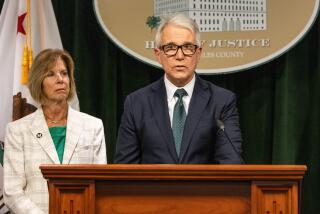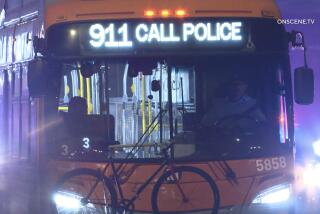Greyhound Bus Crushes Striking Driver
A striking Greyhound bus driver, picketing outside the company’s terminal in Redding, was crushed to death Saturday morning when an Oregon-bound bus driven by a replacement driver pinned him against a concrete wall, authorities said.
Several union members said they tried unsuccessfully to stop the bus after it hit the man. The replacement driver motored out of the city before stopping and flagging down a passing police officer. He was returned to Redding for questioning but not arrested.
Redding police, however, declined to call the picketer’s death accidental, saying only that their investigation was continuing.
The incident was the worst among scattered acts of violence as the nationwide Greyhound strike entered its second day.
Two strikers in Philadelphia remained in custody Saturday after throwing objects at a bus that shattered windows and injured one passenger, police said.
In Chicago, where sniper fire hit a Greyhound bus Friday night, a judge issued a temporary restraining order holding strike leaders responsible for any further violence.
While leaders of the Amalgamated Council of Greyhound Local Unions pleaded for calm, some among their 9,375 members predicted that the situation would only grow more heated as a result of the Redding incident.
Talks have faltered between union and company officials, and none are planned. The strike already has shut down at least 75% of the country’s only nationwide bus system.
“It’s going to be all hell broke loose now,” said Karen Gage, a Sacramento-based Greyhound driver. “All these drivers are asking for is a little money and now people are dying.”
Greyhound President Frank Schmeider said the replacement driver, Theodore Graham, 42, of Portland, Ore., was not at fault for the tragedy in Redding.
“The company as a whole feels an extreme amount of grief, but it’s an accident,” he said. “It was not an act of violence. It was not an act of malicious activity, and it’s an unfortunate thing that happened.”
The picketer was identified as senior driver Robert R. Waterhouse, 59, who would have celebrated his 30th anniversary with Greyhound on June 6. Waterhouse was planning to retire this summer, his wife, Dorie, told The Times.
“The issues of this strike were not really pertinent to him, but he wanted to show support, so he went down to picket and then this driver--I don’t want to use any words--hit him,” Mrs. Waterhouse said. “Bob was of such a gentle nature, you would never expect something so violent to occur.”
A native of Wenatchee, Wash., Waterhouse had driven the Greyhound run from Redding to Portland for the last 2 1/2 years. It was the Portland-bound bus, No. 1505, that struck and killed him.
Waterhouse and his wife had been married seven years and had six children, three each from previous marriages. He had lived for 25 years in Redding, an agribusiness and forestry community of 55,000 located 215 miles northeast of San Francisco.
It was not immediately clear how or why the replacement driver, hit Waterhouse.
Buses departing the Redding terminal must make an immediate 90-degree right turn to avoid a concrete retaining wall that is about 15 feet from the terminal’s exit, drivers say.
Witnesses reported that Waterhouse was holding a picket sign and standing directly in front of the driver’s seat as Graham pulled out of the terminal shortly after 8 a.m. When Graham swung the bus into a turn to avoid the retaining wall, Waterhouse was pinned against the concrete and crushed to death.
Part of the wall was knocked over and a small truck was sideswiped by the bus as Graham drove from the scene, some witnesses said.
Officer Steven Fiddler, a Redding police spokesman, said that when the bus was just north of the city on Interstate 5, Graham pulled over and flagged down “the first officer he saw”--a California Highway patrolman. The patrolman returned Graham to Redding, where he was questioned at length by police.
“It’s not been determined to be an accident,” Fiddler said late Saturday, “but there is no reason to hold (Graham) at this time. He’s not been charged or booked or anything like that--as of yet. The investigation is continuing.”
The passengers aboard Graham’s bus were transferred to another Greyhound coach shortly after the incident and proceeded to Portland, Fiddler said.
Duke Schrank, investigator for the Shasta County medical examiner, said Waterhouse was taken by ambulance to Redding Medical Center, where he was dead on arrival.
Schrank described the cause of death as “blunt force trauma to the trunk.”
“He tangled with a bus and lost,” Schrank said.
In Los Angeles, where tensions among strikers remained relatively calm, officials of Greyhound union Local 1222 suggested that Waterhouse’s death reflected a lack of training of those hired to replace the striking drivers.
“Greyhound is hiring anybody they can get, giving them six days of training and putting them behind the wheel of 10 tons of metal,” said Dick Simpson, financial secretary of the Los Angeles local.
In 1983, during a similar strike against Greyhound, a picketing driver in Zanesville, Ohio, was run over and killed when he fell in front of a bus being used to train a replacement driver.
The company was sold in 1987 to a group of Dallas-based investors headed by Fred G. Currey.
Late last year, Greyhound offered the union a new, three-year contract that included what the company described as a 6.9% increase in wages and benefits in the first year. Union members voted 92% against that offer on Jan. 26, pointing out that they took a 22% pay cut when Currey bought the company.
The drivers walked off the job Friday, stranding thousands of travelers across the United States and prompting confrontations with non-union replacements.
More to Read
Sign up for Essential California
The most important California stories and recommendations in your inbox every morning.
You may occasionally receive promotional content from the Los Angeles Times.










